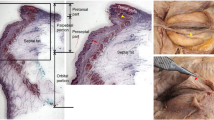Summary
The orbital septum separates the intraorbital fat from the palpebral part of the orbicularis oculi m. An anatomic study after injection of colorant into the intraorbital fat allows definition of a fibroadipose layer anterior to the orbital septum. This consists of radial fibers and extraorbital fatty lobules. The septum is derived embryologically from the mesenchyme of the second arch, but the structure of the anterior layer remains controversial. The septum has an important mechanical function in containing the orbital fat and is involved in orbital movements. A knowledge of these different layers facilitates surgical approaches and helps to define the anatomic landmarks in palpebral surgery for conditions such as ptosis and in blepharoplasty.
Résumé
Le septum orbitaire sépare la graisse intraorbitaire du muscle orbiculaire des paupières. Une étude anatomique après injection de colorant dans la graisse intraorbitaire permet d'individualiser un plan fibroadipeux antérieur au septum orbitaire. Celui-ci est composé de fibres radiaires et de lobules graisseux extraorbitaires. L'origine embryonnaire du septum dérive du mésenchyme du 2ème arc embryonnaire, mais la structure de sa partie antérieure reste controversée. Le septum a une fonction mécanique importante de contention de la graisse orbitaire et il participe à la statique palpébrale. La connaissance de ces différents plans permet de mieux adapter les voies d'abord chirurgicales et de mieux envisager les repères anatomiques dans la chirurgie des paupières telle le ptosis et la blépharoplastie.
Similar content being viewed by others
References
Beard C, Quickert MH, (1988) Anatomy of the orbit. Aesculapius, Birmingham, pp 2–14
Charpy A (1909) Le coussinet adipeux du sourcil. Biblgr Anat 19: 47–52
Gasser RF (1966) The development of the facial muscles in man. Am J Anat 120: 357–376
Jakobiec FA (1982) Ocular anatomy. Embryology and teratology. Harper & Row, Philadelphia, pp 677–679
Jones LT (1964) The anatomy of the upper eyelid and its relationship to ptosis surgery. Am J Ophthalmol 57: 943–959
Koornneef L (1979) Orbital septa anatomy and function. Ophtalmology 86: 876–80
Kronfeld PC, MC Hugh G, Polyak SL (1948) The human eye: anatomical transparencies. Baush Lomb, Rochester
Meyer DR, Linbergs V, Wobig JL (1991) Anatomy of the orbital septum and associated eyelid corrective tissues. Ophthalmol Plast Reconstr Surg 2: 104–113
Rouvière H (1939) Anatomie générale. Origine des formes et des structures anatomiques. Masson, Paris, pp 60–126
Smith BC (1987) Ophthalmic plastic and reconstructive surgery, vol 1. Mosby, St Louis Washington DC Toronto, pp 3–76
Spooner JD (1957) Ocular Anatomy. Hatton, London
Stricker M, Gola R (1990) Chirurgie plastique et réparatrice des paupières et des annexes. Masson, Paris, pp 215–230
Wolff E (1954) Anatomy of the eye and orbit. Blakiston, New York, pp 153–209
Author information
Authors and Affiliations
Rights and permissions
About this article
Cite this article
Brémond-Gignac, D., Deplus, S., Cussenot, O. et al. Anatomic study of the orbital septum (22.10.93). Surg Radiol Anat 16, 121–124 (1994). https://doi.org/10.1007/BF01627937
Received:
Accepted:
Issue Date:
DOI: https://doi.org/10.1007/BF01627937




